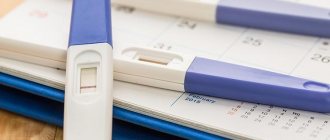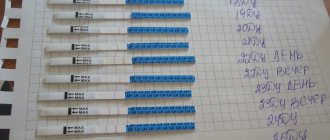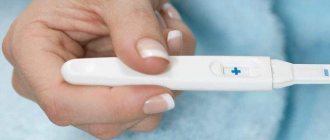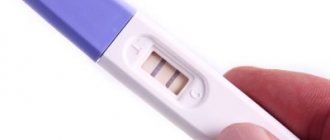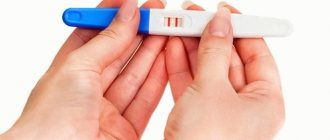Operating principle and diagnostic timing
Before we talk about changes in the result of a pharmacy pregnancy test depending on the day of the cycle, we need to talk about the principles by which the test systems work, why they show two stripes or one. This is very important to understand when and how to self-diagnose.
After fertilization, which biologically and physiologically can only occur on the day the egg is released and within a day after it (while the egg is alive), the embryo begins to move through the oviduct into the uterine cavity, and this journey takes about three days. On the fourth day, the embryo reaches its destination, where implantation occurs after another 1-3 days. Only after the embryo attaches to the inner wall of the uterus does a gradual increase in the specific active substance begin in the body - the hormone hCG, human chorionic gonadotropin.
HCG is produced by the villi of the outer layer of the fetal membrane. They are connected to the blood vessels of the female body, provide nutrition to the baby, supplying useful substances from the mother’s blood. This will happen until approximately the end of the first trimester, until a full-fledged placenta is formed.
Chorionic gonadotropic hormone is present in a certain amount both in women outside pregnancy and in men, but their content is extremely low (from 0 to 5 mU/ml). If a woman has conceived a baby, then the growing level of hCG is designed to support the functioning of the corpus luteum on the surface of the ovaries.
It is formed, regardless of the fact of fertilization or its absence, and producing progesterone.
In a normal cycle, not marked by completed fertilization, the corpus luteum is given a short period of time; already 9-11 days after ovulation it begins to regress. Progesterone production stops, and soon the usual monthly menstrual bleeding begins.
In the cycle, when the meeting of the germ cells of the parents has taken place, after successful implantation the chorionic villi produce hCG, and its growth approximately doubles every two days.
It is on the basis of identifying traces of hCG in urine that absolutely all existing pregnancy tests are based. Whatever test you buy - digital or regular strip, it will “work” the same.
The test has a working test zone with an applied substance - a reagent that is highly sensitive to hCG molecules in the liquid. If the test detects the hormone, the reagent colors the second strip. If not, you get only one line - a control line, indicating that the test is working and suitable for use.
Considering that the hormone increases gradually and only after the embryo has been successfully implanted, test system manufacturing companies advise starting self-diagnosis from the first day of the delay.
By this time, the quantitative indicators of hCG in the urine are sufficient for a test of any sensitivity to determine the desired substance.
Ultrasensitive test systems (with a threshold of 5-20 mIU/ml) can determine hCG earlier, 2-4 days before the start of the delay, but manufacturers do not provide guarantees of obtaining the most accurate result.
HCG calculator (result interpretation)
DPO - days after ovulation. They were scared that the pregnancy was not developing. My period was on November 6, 2014, the cycle was 28-29 days. On day 2, December 6, 2014, the hCG showed 130.4 mmIU/ml.
Hello. Please tell me, I received the hCG results today and I can’t figure them out))) It is written that the total hCG is 80 honey/ml. Hello! The delay is already almost 2 weeks... On the 6th day, hCG was 359.7. On the 8th - 485.7... At first no one was visible in the stomach.
I really want this to be such a long-awaited pregnancy! Hello, we are diagnosing a pregnancy that is not developing. My last period was 06/12/15. The second one was pale. HCG on this day was 57 honey/ml. I am very afraid of a frozen pregnancy. Hello. I'm 4 days late. On the same day, I donated blood for hCG - 33. This means that the content in the urine is even lower. The next day I did a simple frautest again - it barely showed the second stripe.
Pregnancy 9th week from the date of the last menstruation. I took an hCG test and it showed 388,215 honey/ml. On 09/09/15 I took hCG 2.7 and did 2 tests in the evening, all two showed a second weak line and it was visible, and this morning M. started. I was so upset. D. day. The last menstruation was 08/07/15, ovulation according to ultrasound was 08/19/20/15. I took an hCG test on the 30th day of menstruation. Girls, please tell me, yesterday was the 4th day of delay, at 15.30 I took a hCG test, I didn’t understand anything, it says pregnancy 30. HCG Only on the 11th day after ovulation, the hCG level crosses the border of 25 mUI for the first time and a pregnancy test can show for the first time weak second stripe. On the 15th day after the positive test for O., the test for B. showed a very clear second line. But the test for B was negative, there was no delay yet!!! Let's figure out why and try to calculate the probability of a positive pregnancy test depending on DPO (day after ovulation).
How do the results change by day?
We have already found out that at 2-3 DPO (the day after ovulation), the embryo is still on its way to the uterine cavity, and after it is in it (at 4 DPO), it can remain in the state for another day to three or even more. floating freely in the uterine cavity until it “sticks” to the inner wall of the uterus, and the complex process of immersion of the fertilized egg into the endometrium begins. The implantation itself lasts about 40 hours, which is why you should not be surprised that at 5-6 DPO the tests are negative.
Until implantation is complete, hCG will not be produced.
The normal time frame for implantation is considered to be 5-9 days after ovulation.
The later it is done, the later the tests will begin to show the cherished and long-awaited two stripes.
The growth of hCG in urine is an individual matter.
It depends on the functioning of the kidneys, metabolism, the woman’s age and a host of factors that are not directly related to pregnancy. Therefore, it is customary to evaluate the dynamics of hormone growth in the blood - it is more constant and applicable to different women. Keep in mind that during a multiple pregnancy, the quantitative indicators are doubled (if there are two embryos).
In urine, quantitative indicators will be less impressive, and this is quite natural.
Let's look at what happens to test systems day by day. Everything is quite simple here. If the test is ultrasensitive (the packaging indicates a sensitivity of 5 to 10 units per milliliter, mIU/ml), then there is a real chance that such a device will show a weak second strip already 8-9-10 days after the release of the egg, that is, 4 days before expected menstruation.
Sensitive tests (with a threshold of up to 20 units per milliliter inclusive) are able to indicate the second stripe on days 12-13 after ovulation (2-3 days before expected menstruation).
Tests with a standard sensitivity threshold (25 to 30 units per milliliter) may show a second line (weakly or more clearly) after the start of the delay - from 15 DPO.
Please note that the table shows minimum and maximum values. In order not to make a mistake, focus on the minimum, and then you will definitely be able to choose the right day to start testing with the most accurate result.
Pay attention to the increase in the amount of hormone in the blood on the days of the cycle before and after the delay. This will be the answer to the question why the strip, which was initially weak at 11-12 DPO, becomes brighter - the level of chorionic hormone increases, and the reagent marks this with a brighter color.
Negative test at 13 DPO: is there hope?
Since there is no delay on this day yet, this result does not mean that there is no pregnancy. Of course, it's hard not to worry when you've already had several unsuccessful attempts to conceive. However, you will have to wait. To worry less, it is recommended to distract yourself. The results of numerous studies prove that a woman who experiences stress reduces her chances of successfully conceiving by 12%.
In the first two weeks after implantation, the hCG level doubles every 1-2 days. If the fertilized egg entered the uterine cavity on the fourth day after ovulation, then at 13 DPO the hCG level will be only 2 mMEL. At 5 DPO this figure will increase to 4, at the sixth - to 8, at the seventh - to 16, and at the eighth - to 32. An ultrasensitive test will show pregnancy a week after ovulation. Normal - on the eighth day. But this is only if the woman knows exactly the day of ovulation, having determined it not by a schedule or tests, but by ultrasound. After all, the probability of attachment at the third to fifth DPO is only 0.68%. And the fertilized egg can produce hCG at different rates.
If we take average statistics, everything will go even slower. For example, implantation occurred on the eighth day after conception, and hCG increases by 2 times every two days. Therefore, at 9 DPO the hormone concentration will be only 2 mIEMl, at 11 DPO - 4, at 13 DPO - 8, and at 15 DPO - 16. On the first day of the delay, even a high-quality sensitive test will show only a weak second line. But on the third day you will be able to admire the bright and clear line.
It happens that pregnancy develops even more slowly. It's quite normal. Conception at 10 DPO occurs in 27% of cases. Then the hCG will “grow” to 16 mMEml only on the third day of the delay, or at 17 DPO.
DPO signs of pregnancy
Doctors are often skeptical about the described signs of pregnancy before the delay, arguing that changes in the body of the expectant mother during this period are insignificant and there are no pronounced symptoms. However, many expectant and established mothers identify a number of signs by which they suspected pregnancy even before a missed period.
7–10 DPO: signs of pregnancy
- This is the standard implantation period. It may be accompanied by bloody brownish discharge with a tendency to decrease in abundance, pulling or tingling sensations in the lower abdomen, lumbar region, a feeling of warmth, burning in the uterus. Also, during implantation, chills, a slight increase in axillary temperature, and sore throat may be observed.
- Metamorphoses can also occur with the breasts: if a woman in a non-pregnant state had engorged breasts in the second phase of the cycle, then this may not happen during pregnancy. And vice versa: many girls note an uncharacteristic increase in the volume and sensitivity of the mammary glands.
- Appetite often increases during this period - nausea during pregnancy, if it occurs, will occur later, when the level of hCG increases significantly. Gastronomic preferences may change. Some women notice a metallic taste when eating.
- Pregnancy also brings its own adjustments to the rhythm of a woman’s life: for some women, performance decreases due to increased fatigue and feelings of weakness, while others, on the contrary, experience a surge of strength and energy. However, both of them are characterized by some absent-mindedness.
11–13 DPO: signs of pregnancy
- During this period, an increase in the volume of vaginal discharge may be observed, but the nature of the discharge should not be pathological.
- Swelling, a feeling of fullness and nagging pain in the lower abdomen persist, possibly indigestion.
- The mood is changeable, excessive emotionality is possible.
- The sense of smell intensifies.
- Frequent urge to urinate is bothersome.
Types of tests
It's hard to believe, but practice shows that the type of device used to determine pregnancy plays an important role. This is due to the fact that some types of pregnancy tests have a high probability of errors. To determine the success of conception in the early stages, this is an extremely important nuance.
In pharmacies you can find the following pregnancy tests:
- strip strips;
- tablet;
- jet;
- electronic.
They are all used approximately the same way - urine is applied to the receiving end of the device, after which a chemical reaction occurs and information about the level of hCG is displayed.
Short cycle
All of the information above is great for women with normal or long menstrual cycles. In these cases, the level of hCG in the urine on the 10th day after ovulation is low enough to be recognized at home.
Sometimes there are girls with short menstrual cycles. It takes them about 20-21 days from period to period. This is a rare occurrence, but it does happen.
Under such circumstances, ovulation occurs 10 days after the start of menstrual bleeding. And the new cycle should come in another 10-11 days. What does it mean?
If at 10 DPO the test is negative in a girl with a short menstrual cycle, there is often no hope for successful conception. It is recommended to wait. If your period does not come after a week, you need to repeat the express check.
And in this case, the testimony does not allow us to judge whether pregnancy has occurred? Then it’s time to go to the doctor - the delay in menstruation is not caused by pregnancy. You can’t even hope for its onset since the last cycle.
Medication support
For some diseases or unsuccessful attempts to get pregnant, the doctor may prescribe medication. For example, Duphaston. And at 13 DPO the test was negative. Oh in that case or not? Before making a decision, the doctor will send you to a laboratory for a blood test. Further actions will depend on its result. If pregnancy is confirmed, then Duphaston is usually not canceled for some time. If conception does not take place in this cycle, then the medication should be abandoned.
It might be useful to read:
- How to quickly get rid of acne on your face at home What helps get rid of acne;
- How to care for a hamster at home;
- A mercury thermometer has broken - what to do and how dangerous it is;
- Caring for hamsters at home: expert advice;
- “Get to the root,” or what to do if your hair quickly becomes oily;
- The best remedy for dandruff;
- Reflexology - what is it? ;
- Drug therapy involves the appointment of various;
At what DPO should you take a pregnancy test?
- The reagent in pregnancy tests works on the hCG hormone. Secretion of the latter begins the next day after the implantation of the embryo into the wall of the uterus. Implantation usually occurs between 7 and 10 DPO, but in about 10 percent of cases it can occur a day or two earlier or later. If not enough time has passed since implantation, the test will be false negative. And vice versa: with early implantation, the result can be known much earlier than the day of delay.
- The level of hCG produced normally has a fairly wide range. The less the hormone is produced in the female body, the less of it will end up in urine, and the more difficult the task will be for a home rapid pregnancy test.
- Pregnancy test sensitivity. This indicator indicates the minimum amount of hormone that the rapid test can respond to. Ultrasensitive tests can diagnose pregnancy when the hCG content in urine is 10 mIU/ml, which corresponds to 7–10 DPO. On a pregnancy test with a sensitivity of 15 mIU/ml, a positive result is unlikely to appear before 12 DPO. Pregnancy tests with a sensitivity of 20 mIU/ml are intended for use from the 13th day of DPO, with a sensitivity of 25 mIU/ml - from 14 DPO. In the first weeks after ovulation, a negative rapid test cannot be interpreted with absolute certainty as the absence of pregnancy, therefore, if a negative result is obtained, it is recommended to repeat the rapid test a few days later.
- Proper preparation for express diagnostics. In the early stages, to obtain a reliable result, it is recommended to use more concentrated urine. The first urine in the morning is ideal, but urine that has been in the bladder for more than 4 hours can also be used. To avoid diluting your urine on the eve of testing, you should not consume large amounts of liquid, diuretics, or medications.
Why shouldn't you trust the results before the delay?
When will the test show pregnancy, if any? Most special strips can be used from the first day of the delay. However, you should know that there can be a negative test at 13 DPO. This is not surprising, since in a cycle lasting 28 days, it falls just on the last one. That is, in fact there is no delay yet. The concentration of hCG may not have yet reached the required minimum for the test to “react” to it.
The strips have a sensitivity of 20-25 mIUml. Before the delay, only expensive and high-quality pregnancy tests can recognize an interesting position. Within seven to ten days after the expected conception, strips with a sensitivity of 10 mMEml can determine whether a woman will become a mother in the next nine months.
Will the test show pregnancy on the 13th day after ovulation (DPO)? After all, almost two weeks have passed, and it seems that this time is enough to determine an interesting situation. In fact, this is a very short period of time. When there is no delay in menstruation yet (including at 13 DPO), a negative test should not be taken seriously. To get a reliable result, it is better to wait a few more days.
Pregnancy tests for use at home respond to the hCG hormone, which begins to be produced only after the embryo has implanted. Implantation in 18% of cases occurs at 8 DPO, in 36% at the ninth, and in 27% at the tenth. On the remaining days from 3 to 12 after ovulation, the probability of implantation is less than 10%. After attachment, the fertilized egg should begin to produce hCG, a specific pregnancy hormone (chorionic gonadotropin). For the test to accurately determine pregnancy, the hCG level must reach at least 20 mIUml.
The sensitivity of the test is to blame
Day 10 DPO test negative? Don't get upset ahead of time! It is not a fact that the readings from the device for home pregnancy confirmation are not false.
The thing is that modern pregnancy tests have different sensitivity. The lower the number on the test package, the more accurate it will be.
Today you can find devices with sensitivity of 25, 20 and 10 Mme/ml. The bulk of tests have the first “type of accuracy”. This is enough to determine pregnancy in most cases in the first days of a missed period.
The low sensitivity of the test often leads to the fact that a woman sees a false result - the device “says” that there is no pregnancy, but in fact there is one.
Let's watch in dynamics
10 DPO pregnancy test negative? As we found out, there is hope for successfully conceiving a child in one or another menstrual cycle. The main thing is to take your time and be patient.
Moreover, in order not to be nervous again, you can track changes in test results over time. For example, buy several strip strips and check them daily.
So you can often see a negative test first, then a “ghost”, and after a few days a clear second line. Unfortunately, many factors can influence a false test result. Because of them, women often encounter false negative and false positive results.
Electronic tests and early diagnosis
10 DPO test negative? Tightening in your lower abdomen? This may be a sign of pregnancy or impending menstruation. This is how a woman’s body reacts to most hormonal changes.
Modern highly sensitive tests, according to manufacturers, help determine pregnancy 2-3 days before the delay. These are usually electronic devices. They also allow you to see the approximate gestational age.
The girls claim that some tests actually show an accurate result 2-3 days before the expected menstruation. However, it is not recommended to rely on this. Before the period is delayed, the level of hCG in the urine is not high enough. Ideally, do the test 14-15 days after ovulation. This will make it more likely that you will get an accurate result.
Is there hope?
Is it 10 DPO? Test negative? Is there any hope for successfully conceiving a child? As has already been said, there is no clear answer under any circumstances. It all depends on the individual characteristics of the body of a particular girl.
Theoretically, there is hope for pregnancy. Many people claim that the 10th day after ovulation is too early to diagnose the success of conception. On average, there are still 4-5 days before menstruation. This means that, most likely, the test readings will be negative.
From all of the above it follows that there is hope for pregnancy in the described situation, and quite a lot. The main thing is to be patient and wait a little.
When to take the test?
10 DPO test negative? Unfortunately, why this happens is difficult to answer. This is due to the fact that each organism is individual. And girls may not see the second line on a pregnancy test for a very long time due to individual characteristics.
Therefore, it is better to find out when is the best time to test the body for the success of conception. There are different opinions on this matter.
In fact, it's best not to take a pregnancy test until your period is missed. On the first or second day, the test may not give the desired result. And the earlier a girl does the test, the less likely the diagnosis is to be effective.
What does the test respond to?
10-11 DPO - negative test? Before you get upset or happy, you need to understand how pregnancy tests work. Everything is extremely simple and understandable even to a schoolchild.
Modern rapid tests allow you to determine pregnancy in the early stages. They respond to increased levels of hCG in the urine. This hormone is absent in a healthy body.
Accordingly, the second strip will appear during pregnancy when the hCG level rises to a sufficient level. Usually, modern rapid tests make it possible to judge the occurrence of pregnancy around the first delay of menstruation.
Medication support
For some diseases or unsuccessful attempts to get pregnant, the doctor may prescribe medication. For example, Duphaston. And at 13 DPO the test was negative. Oh in that case or not? Before making a decision, the doctor will send you to a laboratory for a blood test. Further actions will depend on its result. If pregnancy is confirmed, then Duphaston is usually not canceled for some time. If conception does not take place in this cycle, then the medication should be abandoned.
Thirteen days after ovulation (13 DPO) and the test is negative? You shouldn’t unequivocally assume that “it didn’t work out again” and get upset in advance. At such a short period of time, not all tests for determining the concentration of the hCG hormone in the urine will show an accurate result.


